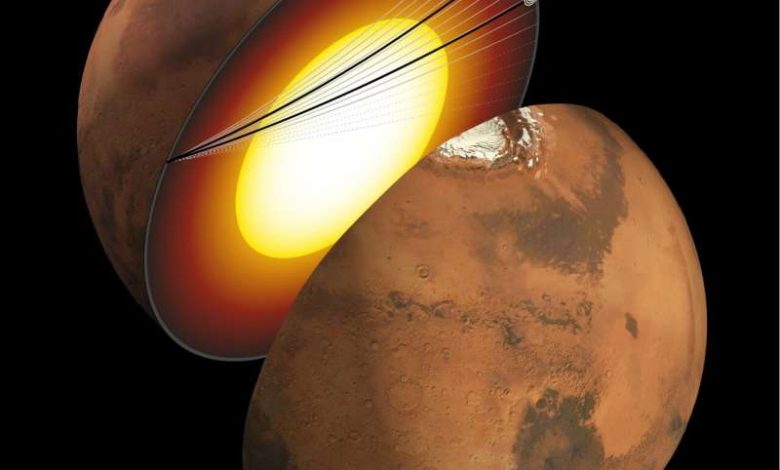Scientists detect seismic waves traveling through Martian core for the first time

Scientists observed seismic waves traveling through Mars’ core for the first time and confirmed model predictions of the core’s composition.
An international research team—which included University of Maryland seismologists—used seismic data acquired by the NASA InSight lander to directly measure properties of Mars’s core, finding a completely liquid iron-alloy core with high percentages of sulfur and oxygen. Published in the Proceedings of the National Academy of Sciences on April 24, 2023, these findings reveal new insights into how Mars formed and the geological differences between Earth and Mars that may ultimately play a role in sustaining planetary habitability.
“In 1906, scientists first discovered the Earth’s core by observing how seismic waves from earthquakes were affected by traveling through it,” said UMD Associate Professor of Geology Vedran Lekic, second author of the paper. “More than a hundred years later, we’re applying our knowledge of seismic waves to Mars. With InSight, we’re finally discovering what’s at the center of Mars and what makes Mars so similar yet distinct from Earth.”
To determine these differences, the team tracked the progression of two distant seismic events on Mars, one caused by a marsquake and the other by a large impact, and detected waves that traveled through the planet’s core. By comparing the time it took those waves to travel through Mars compared to waves that stayed in the mantle, and combining this information with other seismic and geophysical measurements, the team estimated the density and compressibility of the material the waves traveled through. The researchers’ results indicated that Mars most likely has a completely liquid core, unlike Earth’s combination of a liquid outer core and solid inner core.
Additionally, the team inferred details about the core’s chemical composition, such as the surprisingly large amount of light elements (elements with low atomic numbers)—namely sulfur and oxygen—present in Mars’ innermost layer. The team’s findings suggested that a fifth of the core’s weight is made up of those elements. This high percentage differs sharply from the comparatively lesser weight proportion of light elements in Earth’s core, indicating that Mars’ core is far less dense and more compressible than Earth’s core, a difference that points to different conditions of formation for the two planets.
“You can think of it this way; the properties of a planet’s core can serve as a summary about how the planet formed and how it evolved dynamically over time. The end result of the formation and evolution processes can be either the generation or absence of life-sustaining conditions,” explained UMD Associate Professor of Geology Nicholas Schmerr, another co-author of the paper. “The uniqueness of Earth’s core allows it to generate a magnetic field that protects us from solar winds, allowing us to keep water. Mars’ core does not generate this protective shield, and so the planet’s surface conditions are hostile to life.”
Although Mars does not currently have a magnetic field, scientists hypothesize that there was once a magnetic shielding similar to Earth’s core-generated field due to traces of magnetism lingering in Mars’ crust. Lekic and Schmerr noted that this might mean that Mars gradually evolved to its current conditions, changing from a planet with a potentially habitable environment into an incredibly hostile one. Conditions in the interior play a key role in this evolution, as might violent impacts, according to the researchers.
“It’s like a puzzle in some ways,” Lekic said. “For example, there are small traces of hydrogen in Mars’ core. That means that there had to be certain conditions that allowed the hydrogen to be there, and we have to understand those conditions in order to understand how Mars evolved into the planet it is today.”
The team’s findings have ultimately confirmed the accuracy of current modeling estimates that aim to unravel the layers hidden beneath a planet’s surface. For geophysicists like Lekic and Schmerr, research like this is also paving the way for future geophysics-oriented expeditions to other celestial bodies, including planets like Venus and Mercury.
“This was a huge effort, involving state-of-the-art seismological techniques which have been honed on Earth, in conjunction with new results from mineral physicists and the insights from team members who simulate how planetary interiors change over time,” noted Jessica Irving, a senior lecturer at Bristol University and first author of the study. “But the work paid off, and we now know much more about what’s happening inside the Martian core.”
“Even though the InSight mission ended in December 2022 after four years of seismic monitoring, we’re still analyzing the data that was collected,” Lekic said. “InSight will continue to influence how we understand the formation and evolution of Mars and other planets for years to come.”





